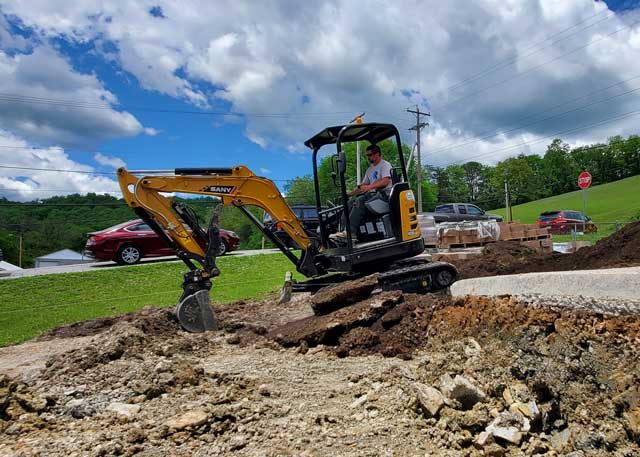Thorough Expedition: The Scientific Research Behind Superior Excavation Practices
From old hand devices to contemporary hydraulic excavators, the development of excavation techniques has actually been a testimony to human ingenuity and technological advancements. What truly establishes remarkable excavation methods apart is a deep understanding of geological principles, paired with the use of advanced tools and methodologies.
Advancement of Excavation Methods
Throughout history, the development of excavation techniques has actually played an important duty in progressing building and construction techniques and archaeological explorations. From the fundamental tools utilized by our forefathers to the innovative equipment employed in modern times, the progression of excavation methods has significantly transformed just how we approach different projects.
In old times, hands-on labor with basic devices such as shovels, wheelbarrows, and pickaxes was the main approach of excavation. This labor-intensive process limited the deepness and scope of excavations, usually causing sluggish development and limited access to certain websites. As worlds progressed, so did the techniques and devices utilized for excavation.
The Industrial Change marked a transforming point in excavation techniques with the introduction of steam-powered equipment. In contemporary times, modern technology plays an essential duty in excavation, with innovations like General practitioner systems, drones, and 3D scanning enhancing precision and performance in the area.
Duty of Modern Technology in Excavation

The combination of cutting-edge innovation has basically transformed the field of excavation, enhancing precision and effectiveness to unmatched degrees - septic ohio. One of the vital technological developments that has actually dramatically impacted excavation techniques is the application of General practitioner systems.
Furthermore, the advent of 3D modeling and simulation software has structured the planning procedure for excavation jobs. Designers and drivers can currently picture the whole excavation process before beginning, enhancing and determining prospective challenges operations. Together with this, the implementation of drones in excavation tasks has actually helped with airborne surveys, volumetric dimensions, and site assessments with unparalleled rate and accuracy.
Geological Concepts in Excavation
An understanding of geological concepts is vital for ensuring the structural stability and security of excavation sites. Geological aspects play an essential duty in determining the usefulness and security of excavation projects (lancaster trenching). One crucial geological concept to think about is the type of soil or rock existing at the site. Various dirt kinds, such as sand, clay, or crushed rock, have differing degrees of stability and require different excavation methods. For circumstances, cohesive dirts like clay may call for extra support to avoid collapses, while sandy soils may be prone to disintegration throughout excavation.
By carrying out thorough geological studies and evaluation, engineers and excavators you could try here can develop techniques to minimize risks and make sure the effective completion of excavation tasks. Inevitably, integrating geological concepts into excavation methods is critical for achieving secure, efficient, and sustainable outcomes.

Latest Tools for Excavation
In the realm of excavation practices, contemporary innovations in tools have actually changed the performance and accuracy of excavation procedures. One of the most up to date tools making waves in the industry is the use of drones geared up with advanced imaging technology. These drones can offer comprehensive aerial studies of excavation websites, using real-time data on topography and potential hazards. This details help in far better preparation and decision-making during the excavation process.
One more cutting-edge tool acquiring popularity is the implementation of 3D printing technology for producing custom-made excavation equipment. This permits the manufacturing of specialized tools that are customized to the particular needs of a job, increasing performance and minimizing downtime.
Furthermore, innovations in materials scientific research have brought about the advancement of more powerful and a lot more durable excavation devices. lancaster trenching. Tungsten carbide-tipped excavator add-ons, for example, deal exceptional efficiency in challenging ground conditions, boosting productivity on-site
Scientific research's Influence on Excavation Practices

Moreover, improvements in materials scientific research have actually resulted in the creation of more powerful, much more sturdy excavation devices and devices. For example, using composite products in shovels and diggers has boosted their efficiency and long life, inevitably enhancing productivity on excavation websites. Furthermore, scientific research study on soil auto mechanics and geotechnical design has given important understandings into dirt actions, enabling excavation specialists to make educated decisions concerning excavation methods and dirt stabilization methods. Overall, science remains to drive development and renovation in excavation techniques, making excavation projects a lot more reliable, affordable, and lasting.

Conclusion
To conclude, the evolution of excavation strategies has actually been considerably influenced by developments in technology and a much deeper understanding of geological concepts. The most recent tools and tools used in excavation have improved performance and precision in the field. The application of clinical understanding has substantially enhanced excavation techniques, causing much more effective and lasting techniques for excavating various sorts of products.
In the world of excavation techniques, modern advancements in devices have actually changed the efficiency and accuracy of excavation processes. By leveraging scientific principles, the excavation sector has actually been able to substantially improve news performance, precision, and safety in excavation processes. GPR enables excavation teams to non-invasively check and map subsurface frameworks, utilities, and possible threats, enabling them to intend excavation jobs with higher precision and lowered danger of mishaps.
Additionally, clinical study on check my source dirt auto mechanics and geotechnical design has actually offered valuable understandings into dirt habits, allowing excavation experts to make informed choices relating to excavation methods and dirt stablizing techniques. Overall, scientific research continues to drive technology and improvement in excavation practices, making excavation tasks more effective, affordable, and lasting.